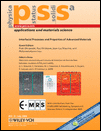Si-oxide/Si and Si-oxynitride/Si interfaces analysed by ultra-low energy SIMS
Abstract
Depth profile analyses of silicon oxides and oxynitrides are compared using SIMS (Secondary Ion Mass Spectrometry) technique with ultra low energy of primary Ar+ ion beam. SiO2 (5–80 nm thick) layers on p-Si 〈100〉 were formed by thermal heating of silicon wafers in oxygen flow. SiOx Ny (2–4 nm thick) layers on p-Si 〈100〉 were obtained by nitrogen implantation followed by plasma oxidation process. The nitrogen implantation was performed with NH3 and N2 plasma sources in 350 °C. The influence of r.f. power, used during implantation on the oxynitride layer properties, was studied.
SIMS measurements were done using ultra-low energy 880 eV Ar+ beam and quadrupole mass spectrometer. Quantitative atomic concentrations of nitrogen and oxygen were calculated basing on Si2N+, Si2O+ and Si2+ secondary ion currents. The obtained layers were also characterised by X-ray Photoelectron Spectroscopy, ellipsometry and electrical tests. (© 2006 WILEY-VCH Verlag GmbH & Co. KGaA, Weinheim)




